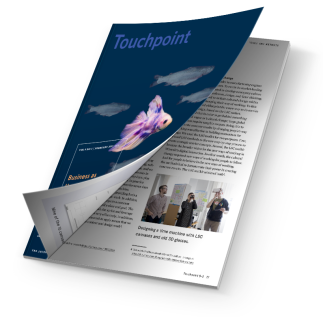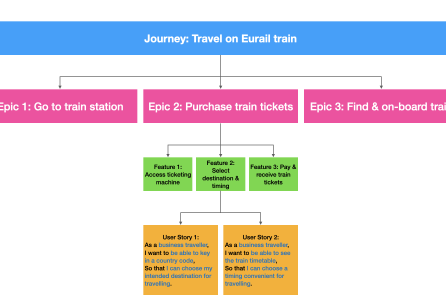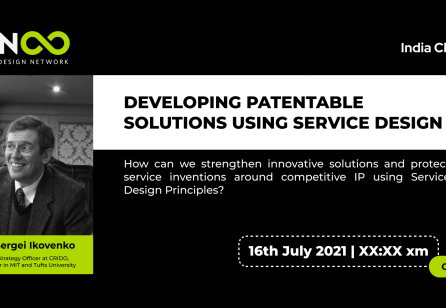This is changing the nature of our creative working relationships with clients, managers, and colleagues from other disciplines. Working with others to align and integrate a holistic vision across delivery channels for a complex service brand raises new tactical and process challenges for service designers. We may be discovering that, regardless of the project or industry, the answer may lie in how we apply service design thinking to our own daily team practices.
The service design community welcomed the release of the Design for Service Innovation & Development Final Report (DeSID)1 as it provided a theory and framework to describe categories of service design projects that designers are now encountering. Case studies contextualised the role of service design in areas of new service development and innovation, and described the evolving nature of the designer/client relationship. This led me to reflect on the nature of recent service design projects that I had worked on and the stories I’d heard from colleagues. The projects fit DeSID’s descriptions, but there are also deeper patterns in what my colleagues and I are experiencing on these project teams. New challenges present themselves and we are discovering ways to successfully address them. In this article, I’ll call these ‘practices in place’: how to apply service design principles to actions and choices while working on new services and service innovation projects. Using the Design Council’s descriptions of the DeSID categories as a framework, I’ll describe what the challenges look and feel like, share examples from my experience with design teams and partners, and detail how specific practices have helped to transform project outcomes and positively influence how people adopt service design tools and methods on internal teams.
Project Category 1: “Service Design as a Skilled Contribution to Address a Specific Need”
“Designers and clients tend to have distinct roles [and make] separate contributions to the design work.” Projects are often “for the development of new services… at the early stage, with emphasis on design activities that can inspire and inform change, such as user studies.” (Design Council)
What the challenge looks and feels like: While clients and designers still maintain distinct roles, the clientdesigner relationship during the design process has become more directly engaged, as both renegotiate how they work together. The client may ask the consultant’s designers to work on-site for the project duration or hold meetings more frequently to collaborate closely with in-house expertise.
Case study: A US-based home-improvement chain hired our consultancy to design and test an in-store service experience in ten weeks. The request for proposal (RFP) followed a traditional client/consultant model of process, milestones and deliverables. Because the service delivery was complex, both the client and our design team realised we needed regular input from the client’s internal domain experts. Previous weekly status meetings had been time consuming and didn’t allow for productive knowledge sharing and collaboration with the experts. To create a better means of working effectively and generatively, the design team asked for a more direct engagement.
Practice-in-Place: Co-design a Co-creative Relationship with the Client
During the contracting phase, our design team brainstormed with the client ways to engage their experts in the design process while being mindful of the experts’ busy schedules. By exploring alternatives before the project began, all parties could agree, set expectations, and feel comfortable with changes to the traditional client/designer relationship.
How we applied service design thinking to the relationship:
- Transform the one-hour status meeting into a working session. The client was skeptical of methods that would feel too ‘workshop-y’ so we took a light-handed, but vigilant approach to visualising the experts’ knowledge-transfers, ideas and feedback through whiteboard diagramming and storyboard sketching. Meetings became more productive and our design team left the meetings with tangible documentation and decisions that we didn’t need to reproduce after-the fact. The experts began using the sketches as conversation tools between meetings to collect additional stakeholder feedback.
- Use the kick-off meeting to pilot the working relationship with individuals. We demonstrated the work session protocol for the weekly meeting at the start of the project so all domain experts at the client were comfortable with how we worked and could suggest improvements for how best to engage with them.
In this case, our design team was still acting to provide a specific, skilled contribution to the client’s project, but by formally negotiating frequent, co-creative engagements with the client up front, we were able to save time while building greater rigour into our service experience solution.
There was also a secondary benefit: By inviting the client experts to participate in fast, iterative ideation and decision-making with our design team, they gained exposure to new practices. Clients like this one have told me that these experiences of direct engagement with our ways of working open what they previously perceived as the black box of design practice. This increase in engagement with the client may be one of the reasons we’re seeing growth in project work in the next category
Project Category 2: “Service Design as a Peoplecentred, Creative and Systematic Process”
In this category, “clients are keen to learn from service designers to improve their existing innovation practices… Projects do not necessarily have clear deliverables – rather [new] design processes have an impact on how the client works.” (Design Council)
What the challenge looks and feels like: There are more opportunities to offer service design training to nondesigners. However, clients run the risk of mistaking introductory tools and methods for a single, silver-bullet process that cannot fully deliver the value of a deeper methodology practiced by experienced service designers
Case study: At a US financial services company, I was part of a team that offered a series of introductory service design thinking workshops to product managers, designers, engineers and executives. The workshops effectively promoted the value of service design to managers through active learning, walking through a series of steps to conduct discovery research, model, ideate, and test service improvements. Several managers were then inspired to apply what they learned to their business challenges. Project sponsors formed incubators staffed with cross-disciplinary teams of non-designers. After months of work and some confusion over how to apply the introductory methods to more complex service challenges, the executives monitoring the projects decided the outcomes were insufficient to green-light further development of the service concepts. The results led some executives to question the value of service design. Our training team realised that the fastest skills transfer might happen by embedding ourselves and other experienced service designers on the teams to coach nondesigners on how to apply more advanced principles and methods to their project work.
Practice-in-Place: Become a Player-Coach
Out training team began to call this role of embedded designer the ‘player-coach.’ In design, as in sports, a player-coach is one who actively plays on a team while coaching other players. In the player-coach role, I learned to be mindful that I am not an instructor. An instructor directs both process and content of a workshop; a player-coach directs use of tools and methods, but does not own the project or process (this belongs to the team or manager). In this context, the service design playercoach is most effective when demonstrating mindsets and practices that others can emulate, assuming a partnering role rather than telling others what to do.
How I applied service design thinking to practice:
- Treat coaching as a service design activity. I exposed the incubator team to a variety of tools and methods, and designed research protocols for them that were customised to address the teams’ questions. As we worked with each method, I gathered feedback on whether a tool or method was working effectively for them or not. I also made it a goal to demonstrate daily how to make data, insights, and ideas both visual and tangible, and monitor how this transformed conversations and thinking.
- Remember that ‘map’ and ‘model’ are verbs. On one incubator team, the members had developed a service model based on research findings, but didn’t know how to communicate the holistic, yet detailed vision to domain experts for feedback. I showed the team lead how to blueprint the service model by having him dictate the concept while I laid it onto the swim lanes of a blueprint. We co-designed the blueprint format based on his content. I then asked him to teach the blueprinting activity to other team members in order to refine their shared mental model of the service concept while passing along how to use the new mapping technique. The model evolved as each team member then introduced the model to domain experts, so they could record ideas, troubleshoot, and refine the service model. Our team found that, after three rounds, we had effectively socialised a detailed mental model of the service, along with a co-created protocol and set of symbols for collaborating with stakeholders. The map continued to evolve into a digital version for wider distribution and was later split into documents for implementation.
- Radically engage managers, front-line employees, back-end producers, distribution channels, etc. I and other player-coaches began to experiment with engaging stakeholders early through informal ‘tours’ of the incubator spaces and invitations to sit in briefly on a working session, as an alternative to formal presentations. This led to further engagements with other incubator members, who often came from the same business units. By the time our team had a green light to implement, production and operations leads were already familiar with or had contributed to the service concept.
In the role of player-coach, I began to view sharing service design skills as a form of collaborative discovery with teammates from other disciplines, rather than as coaching or direction, and as such, a more effective way to influence the design culture within a services company. Tracking and supporting this influence then becomes a key activity for the final project category.
Project Category 3: “Called to Inform How the Client Thinks, Works, and Delivers Services” On these projects, service designers introduce “a collaborative mindset within an organisation and design becomes a way of experimenting with new approaches. When successful, [projects] have a wide ripple effect on the way services are designed and delivered and how the client perceives their own work and identity.” (Design Council)
What the challenge looks and feels like: Designers and clients are pressed to demonstrate or measure the impact of service design.
Case study: A financial services company I worked for manages employer retirement plans and also delivers this service to its own employees. This means its human resources group is a customer of its retirement planning service group. Several years ago, the two groups introduced an initiative to automatically deduct contributions from employee wages so they would receive additional retirement funding from the company. Both groups assumed that employees didn’t understand that if they saved a certain percentage of their earnings for retirement, they would receive an extra contribution from the company. The HR group based the rollout of the initiative on this assumption. Employees complained about the payroll deductions and human resources discontinued the program.
Later, the two groups reinitiated the project. I was embedded as a service design player-coach on a crossdisciplinary team of executives who, working part-time, wanted to try using a human-centered design process. Through user research, the team discovered that their assumption – that employees didn’t understand the retirement plan – was incorrect. Employees wanted to save, but the financial hardship of unforeseen expenses such as medical bills and spousal job loss made it impossible to sustain saving over time. The team piloted and tested an internal savings support service and designed on-boarding communications that empathised with employees’ struggles while positively reinforcing their identity as financially smart. The second rollout of the automatic payroll deduction was a success, with fewer than 12% withdrawing from the program.
Practice-in-Place: Advocate through Individuals Who Embody the Narrative
With this project, it was possible to measure and compare the attrition rates of the two ‘before’ and ‘after’ rollouts. However, the design team’s greater success came from the project’s influence on the organisation and their ability to track it.
How I applied service design thinking to the project:
- Firmly guide methodology, but give stakeholders enough autonomy to feel ownership. A team of experienced researchers might have been more methodologically rigorous, but because non-designer executives had first-hand experience interviewing and testing concepts with employees, they became powerful advocates with greater credibility for communicating the value of the methods and integrating findings from the project into other programs they ran. This made it easier to track the project’s influence.
- Make the experience memorable and “sticky.” My secondary service design role was as a documentarian of their story about learning the value of service design first-hand. By producing a kit of videos, a playbook, posters, and presentations, the executives had a supporting set of materials through which to promote the story throughout the two divisions. Their advocacy along with their tested touchpoint solutions influenced not only which projects their division implemented, but how they were implemented in ways that could be tracked back to the discovery research.
Each practice presented here is ultimately about delivering a kind of service to the people we partner with daily; we are spontaneously co-creating value exchanges that make our project teams’ discovery, design and development processes more meaningful and effective. In this way, we are each putting service design thinking into practice as we embrace constantly evolving project work.









Share your thoughts
0 RepliesPlease login to comment